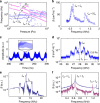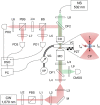Laser-induced rotation and cooling of a trapped microgyroscope in vacuum
- PMID: 23982323
- PMCID: PMC3763500
- DOI: 10.1038/ncomms3374
Laser-induced rotation and cooling of a trapped microgyroscope in vacuum
Abstract
Quantum state preparation of mesoscopic objects is a powerful playground for the elucidation of many physical principles. The field of cavity optomechanics aims to create these states through laser cooling and by minimizing state decoherence. Here we demonstrate simultaneous optical trapping and rotation of a birefringent microparticle in vacuum using a circularly polarized trapping laser beam--a microgyroscope. We show stable rotation rates up to 5 MHz. Coupling between the rotational and translational degrees of freedom of the trapped microgyroscope leads to the observation of positional stabilization in effect cooling the particle to 40 K. We attribute this cooling to the interaction between the gyroscopic directional stabilization and the optical trapping field.
Figures






References
-
- Julsgaard B., Kozhekin A. & Polzik E. S. Experimental long-lived entanglement of two macroscopic objects. Nature 413, 400–403 (2001). - PubMed
-
- Wilson-Rae I., Nooshi N., Zwerger W. & Kippenberg T. J. Theory of ground state cooling of a mechanical oscillator using dynamical backaction. Phys. Rev. Lett. 99, 093901 (2007). - PubMed
-
- Groblacher S. et al.. Demonstration of an ultracold micro-optomechanical oscillator in a cryogenic cavity. Nat. Phys. 5, 485–488 (2009).
-
- Barker P. F. Doppler cooling a microsphere. Phys. Rev. Lett. 105, 073002 (2010). - PubMed
-
- O'Connell A. D. et al.. Quantum ground state and single-phonon control of a mechanical resonator. Nature 464, 697–703 (2010). - PubMed
Publication types
LinkOut - more resources
Full Text Sources
Other Literature Sources

